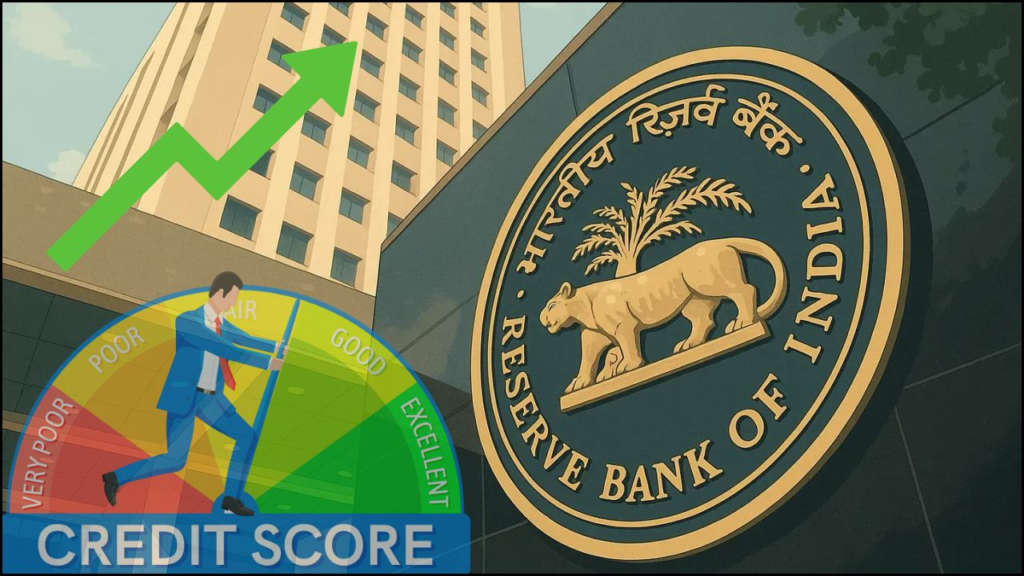
The Reserve Bank of India (RBI) has introduced a set of new rules aimed at improving loan accessibility, particularly for individuals with low or no CIBIL scores. These reforms are designed to ensure greater financial inclusion by enabling borrowers who traditionally struggle to secure loans due to poor credit histories to have a fairer chance. The new regulation is expected to reshape the way banks and financial institutions assess creditworthiness, making the loan application process more transparent and equitable.
What Does the New RBI Rule Say?
The most significant aspect of the new RBI rule, which came into effect in early 2025, is that it prohibits financial institutions from outright rejecting loan applications based solely on a low CIBIL score. CIBIL (Credit Information Bureau India Limited) is one of the primary credit bureaus in India, and its score plays a major role in determining an individual’s creditworthiness.
Under the new regulation, banks and other lending institutions must consider a broader range of factors when evaluating loan applications, rather than relying exclusively on the CIBIL score. This means that individuals with lower scores, or those who do not have a credit history, can still qualify for loans if they meet other criteria, such as regular income, savings patterns, and existing debt-to-income ratios.
The RBI’s move is part of a broader effort to make credit more accessible to underserved sections of society, such as students, small business owners, and low-income individuals, who may otherwise be excluded from the formal credit system due to a lack of sufficient credit history.
What Does This Mean for Borrowers?
1. Expanded Access to Credit
Previously, individuals with low CIBIL scores faced significant barriers to borrowing, as most lending institutions relied heavily on these scores to assess risk. Now, with the new rules in place, a more comprehensive approach is being taken. Borrowers who have regular income but have struggled to build a credit history, such as first-time loan applicants or people new to credit, may find it easier to secure financing.
The new policy also introduces a level of flexibility in how lenders assess an applicant’s creditworthiness. For example, instead of focusing solely on the CIBIL score, banks will now also consider factors like the applicant’s income consistency, job stability, and overall financial behavior.
2. Accelerated Credit Updates
In another key aspect of the RBI’s new rule, the timeframe for updating credit reports has been reduced. Under the previous guidelines, updates to credit reports were typically provided every 30 to 45 days. With the new rule, this has been shortened to every 15 days. This change ensures that any improvements in a borrower’s credit behavior, such as clearing outstanding debts or making timely loan repayments, are reflected sooner in their credit history. As a result, individuals who demonstrate consistent financial responsibility may see their creditworthiness improve more quickly, allowing them to qualify for larger loans in the future.
3. Transparency and Accountability
To increase transparency, the RBI’s regulations now mandate that borrowers must be notified whenever their credit report is accessed. This provides an added layer of security, preventing unauthorized checks and allowing individuals to monitor who is reviewing their financial history. Additionally, lenders are required to clearly explain the reasons behind any loan rejection, helping applicants understand the factors that contributed to the decision.
Implications for Lenders and the Credit System
For financial institutions, the RBI’s changes mean a shift in how credit risk is assessed. While CIBIL scores will remain an important tool, they will no longer be the sole deciding factor. Lenders will need to adopt more holistic methods of evaluating applicants, incorporating both traditional financial factors and alternative data sources, such as income trends or even social behavior patterns. This may require banks to invest in new technologies and training to ensure they are adequately equipped to handle the new system.
One potential challenge for banks is that they may need to adjust their risk models to accommodate the new rules. While the broader inclusivity is beneficial, it may also introduce a slightly higher risk for lenders, as they may have to rely more on alternative data or untested credit histories. However, the RBI has indicated that measures will be put in place to support institutions in managing these risks, ensuring the stability of the financial system.
Challenges and Concerns
Despite the positive intentions behind the RBI’s reforms, there are some challenges and concerns that could arise. For one, while alternative credit assessments may open doors for more borrowers, there is a possibility that they could result in inconsistent lending practices across different institutions. Additionally, some critics argue that without a strong regulatory framework, there may be instances where risky borrowers manage to access credit they are unable to repay, leading to higher default rates.
To address these concerns, the RBI has emphasized the importance of ensuring financial literacy among borrowers, especially in rural and underserved areas. Furthermore, banks are encouraged to use data responsibly and ensure that their lending practices remain prudent despite the expanded access to credit.
Potential for Financial Education Initiatives
The RBI’s new rules are also accompanied by a call for greater financial literacy initiatives. While the changes aim to increase access to credit, the RBI acknowledges that a lack of financial awareness among potential borrowers could undermine the effectiveness of these reforms. Financial education campaigns will play a crucial role in helping individuals make informed borrowing decisions. These campaigns could provide guidance on how to manage loans, understand credit scores, and improve financial behavior.
Alternative Credit Scoring Models
One of the more innovative aspects of the RBI’s new regulations is the allowance for alternative credit scoring models. These models, often called “alternative credit data,” assess a borrower’s creditworthiness using data beyond traditional credit reports. For example, utility bill payments, rental history, and even mobile phone payment records could be used to supplement traditional credit scores. This shift has the potential to dramatically increase the pool of eligible borrowers, especially in rural areas where traditional credit history may be sparse or nonexistent.
The adoption of alternative credit scoring models could further reduce the dependency on traditional credit scores like CIBIL. As these models are adopted, they will need to be carefully monitored and regulated to ensure that they are fair and accurate.
How to Leverage the New Rules as a Borrower
For individuals who may have struggled with securing loans in the past, the RBI’s new rules present a unique opportunity. However, it is important to approach this opportunity with a clear understanding of how lenders are likely to assess creditworthiness under the new framework.
Here are a few key steps to improve your chances of securing a loan:
- Demonstrate Stable Income: Lenders are increasingly looking at income stability. Borrowers who have consistent earnings from a stable job or business are more likely to be approved, even with a lower CIBIL score.
- Ensure Timely Repayments: The new system emphasizes improved financial behavior. Even if your credit score is low, showing that you are able to manage and repay debts on time will go a long way in improving your chances of securing a loan.
- Provide Alternative Data: If you lack a formal credit history, consider submitting alternative data that may help demonstrate your financial responsibility. This could include bills, rental payments, or even bank statements showing regular saving habits.
- Stay Informed About Financial Education: Borrowers should actively engage with available financial literacy resources, which will help them understand credit better and make smarter borrowing decisions.
Looking Ahead: The Future of Credit Access in India
The RBI’s new rule marks a significant step towards transforming India’s financial ecosystem. It not only creates opportunities for individuals with lower CIBIL scores but also challenges the traditional methods of credit assessment. With the enhanced focus on financial inclusion and greater flexibility in evaluating loan applications, this reform is likely to be a game-changer for many borrowers in India.
However, its success will depend on how effectively lenders adapt to the new regulations and how well borrowers are educated about their rights and responsibilities in the loan process. As India continues to digitize and modernize its financial systems, such measures will be crucial in ensuring that a larger portion of the population is included in the formal economy.
Conclusion
The RBI’s latest reforms represent a bold step towards democratizing access to credit. By removing the CIBIL score as the sole determinant for loan eligibility, these changes empower individuals from various socioeconomic backgrounds to access credit. While challenges remain, the shift toward alternative credit scoring and increased transparency can pave the way for a more inclusive financial future in India.
















